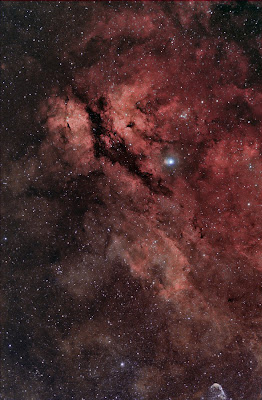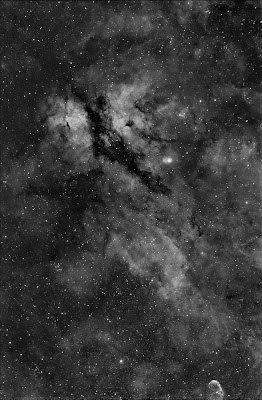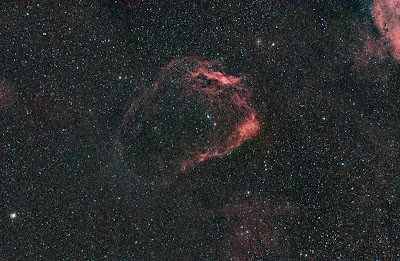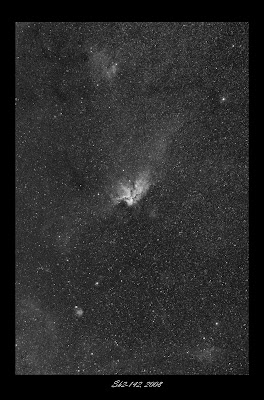COPYRIGHT, PLEASE NOTE
All the material on this website is copyrighted to J-P Metsavainio, if not otherwise stated. Any content on this website may not be reproduced without the author’s permission.
BUY A MUSEUM QUALITY POSTER
BUY A POSTER:https://astroanarchy.zenfolio.com/
Showing posts sorted by relevance for query QHY8. Sort by date Show all posts
Showing posts sorted by relevance for query QHY8. Sort by date Show all posts
Thursday, July 17, 2008
Sh2-240 Reprocessed

This was really hard to catch and process.
Somehow better now, I think.
The Sh2-240 (Simeis 147) is a very faint supernova remaint in Taurus.
The image is in false color to show hydrogen alpha emission.Original BW H-alpha image at the bottom
-
IMAGING DETAILS
-Optics:
Canon FD 200mm f2.8 lens with full aperature
- Camera:
QHY8
- Platform and guiding:
LX200 GPS 12" with QHY5 guider and PHD-guiding
- Exposures:
10 x 3600s + 4 x 2700s + 3 x 900s H-alpha + Flats and Bias frames, no darks
exposure time so far 13h 45min.
- Filter:
Baader 7nm H-alp + IDAS LP for RGB

H-alpha
Thursday, August 11, 2011
Butterfly Nebula, apparent scale in the sky, a horizontal edition
I have shot many targets with several focal lengths.
Due that, I will publish some images as an image sets, with different field of view and detail levels.
The fractal nature of our universe stands out nicely by this way and it will make the orientation more easy.
Many times, it's difficult to understand the image scale of astronomical images.
Due that, I will add a Moon circle in some of the images to show the angular scale in a sky.
The full Moon has an angular size of ~30 arc minutes, that's equal to ~0,5 degrees.
NOTE. The size of the full Moon (0,5 degrees) is marked as a gray circle in all of the images.
Images are in HST-palette, (HST=Hubble Space Telescope) from the emission of ionized elements, R=Sulfur, G=Hydrogen and B=Oxygen. Star colors are mixed from the NB channels, Red=H-a, G=O-III and B= 85%O-III + 15%H-a.
Natural color composition from the emission of ionized elements, R=80%Hydrogen+20%Sulfur, G=100%Oxygen and B=85%Oxygen+15%Hydrogen to compensate otherwise missing H-beta emission. This composition is very close to a visual spectrum.
NOTE. The size of the full Moon (0,5 degrees) is marked as a scale.
A vertical version of the series above:
Images used in the series above
First image is a three panel mosaic of the "Cygnus Trio"
Second one is two panels from a mosaic.
Third is a one panel
fourth is a zoomed crob from the above image.
The mosaic wide field was shot with a Tokina AT-X 300mm f2.8 camera lens with a QHY8 astro camera and a Baader narrowband filter set
All images in this page have been part of an older mosaic, the "Cygnus Trio"
It was my very first APOD (Astronomy Picture Of Day) published by NASA.
http://astroanarchy.blogspot.com/2008/11/apod.html
It was my very first APOD (Astronomy Picture Of Day) published by NASA.
http://astroanarchy.blogspot.com/2008/11/apod.html
Thursday, January 20, 2011
IC 1396 reprocessed
Since my processing technique gets better and weather doesn't give any support, I have reprocessed some older images. There is now star colors added and other processing is tweaked too.
IC 1396
In constellation Cepheus
Image is in HST-palette, (HST=Hubble Space Telescope)
from the emission of ionized elements, R=Sulfur, G=Hydrogen and B=Oxygen.
Star colors are mixed from the NB channels, Red=H-a, G=O-III and B= 85%O-III + 15%H-a.
Nebula is imaged with a Tokina AT 300mm f2.8 camera optics and the QHY8 cooled astro camera.
Technical details with an original image.
Natural color composition from the emission of ionized elements, R=80%Hydrogen+20%Sulfur, G=100%Oxygen and B=85%Oxygen+15%Hydrogen to compensate otherwise missing H-beta emission. This composition is very close to a visual spectrum.
Star colors are mixed from the NB channels, Red=H-a, G=O-III and B= 85%O-III + 15%H-a.
Original versions from October 2008, with technical details:
Monday, September 23, 2013
Sharpless objects, 223, 224 and 225 in Auriga, reprocessed
I'm waiting the weather to clear, to be able to open up my Autumn season. While waiting, I have practiced my processing skills, after a long Summer pause.
Sh2-223, 224 and 225
In constellation Auriga, click for a large image.
Image is in mapped colors, from the emission of ionized elements, R=Sulfur, G=Hydrogen and B=Oxygen.
Image in visual spectrum
A closeup of the supernova remnant Sh2-224
Info
Sh2-224: http://it.wikipedia.org/wiki/Sh2-224
Sh2-225: http://it.wikipedia.org/wiki/Sh2-225
About the new processing
I have used a new technique to dig out a very dim background nebulae. A starless version of 16h H-a exposure is stretched to an extreme and a data in level of background bias is revealed.
To work, images, used with this technique, has to be perfectly calibrated with bisas corrected flats.
The power of this method can be seen easily, if the new image is compared to an older version HERE.
A data hiding near the background level is revealed in this starless image.
This "tone map" is used to boost an extreme dim background nebulae in the final image.
Technical details
Camera, QHY9
Optics, Canon EF 200mm f1.8 @ 1.8
Guiding, QHY5 and PHD-guiding
Imaging platform, LX200 GPS 12"
Exposures
H-alpha, 7x1200s, 13x2400s and an additional
15x1200s imaged with QHY8 and Tokina AT 300mm f2.8
O-III, 5x300s Binned 4x4
S-II. 5x300s. Binned 4x4 .
A single 1200s H-alpha frame
Calibrated, stretched and scaled down, no other processing
This single 20 min. exposure shows how dim this target really is.
There are very few images about this area of sky around.
There are very few images about this area of sky around.
Wednesday, June 8, 2011
A reprocessed panorama of "Heart & Soul" Nebuale
While making scale studies from various objects, I did make some new panoramas from archived images.
I will publish some of them as an individual images, comments and suggestions are welcome.
From IC 1848, the "Soul Nebula" to the IC 1805, the "Heart Nebula"
Two panel mosaic panorama
In constellation Cassiopeia
Natural color composition from the emission of ionized elements, R=80%Hydrogen+20%Sulfur, G=100%Oxygen and B=85%Oxygen+15%Hydrogen to compensate otherwise missing H-beta emission.
This composition is very close to a visual spectrum.
Image is in HST-palette from the emission of ionized elements, R=Sulfur,
G=Hydrogen and B=Oxygen.
Original mosaic with a technical details:
Image is taken with a Tokina AT-X 300mm f2.8 camera lens and a QHY8, a cooled astronomical camera. Baader narrowband filter set, total exposure time was ~9h
Labels:
Narrowband color images
Sunday, January 16, 2011
A supernova remnant, the "Veil Nebula" reprocessed
Since my processing technique gets better and weather doesn't give any support, I have reprocessed some older images. There is now star colors added and other processing is tweaked too.
Veil Nebula
Ra 20h 45m 38.0s Dec +30° 42′ 30″
from the emission of ionized elements, R=Sulfur, G=Hydrogen and B=Oxygen.
Star colors are mixed from the NB channels, Red=H-a, G=O-III and B= 85%O-III + 15%H-a.
optically it has lowish surface brightness.
Natural color composition from the emission of ionized elements, R=80%Hydrogen+20%Sulfur, G=100%Oxygen and B=85%Oxygen+15%Hydrogen to compensate otherwise missing H-beta emission. This composition is very close to a visual spectrum.
An older image from 2007 of Eastern part of the nebula, NGC 6995. Sky Watcher 80 ED with an UHC-s filter and QHY8. Exposure time about 4h.
Natural color composition from the emission of ionized elements, R=80%Hydrogen+20%Sulfur, G=100%Oxygen and B=85%Oxygen+15%Hydrogen to compensate otherwise missing H-beta emission. This composition is very close to a visual spectrum.
Star colors are mixed from the NB channels, Red=H-a, G=O-III and B= 85%O-III + 15%H-a.
An older image from 2007 of Eastern part of the nebula, NGC 6995. Sky Watcher 80 ED with an UHC-s filter and QHY8. Exposure time about 4h.
Original versions from Autumn 2008, with technical details:
I have made an experimental movie about the structure of the nebula. It can be found here:
Thursday, January 31, 2008
Saturday, September 27, 2008
Butterfly Nebula, second try

O-III = Blue. Green channel is Synthesized from Red and Blue.
-
Conditions were not too good last night, hard wind and clouds.
Guiding was really difficult doe the wind but PHD-guiding software does its best.
There was jus enough gaps between clouds, that I managed shot data for H-alpha
and O-III not enough though.
Actually part of the frames are shot trough not so thin clouds, maybe
H-alpha acts as a cloud filter : )
S-II data had to be left to the next time after the clouds rolled in.
Part of the NGC6888 the "Crescent Nebula" can be seen in the bottom of the image.
-
Imaging data:
-
Camera,
QHY8
-
Filters,
Baader 7nm H-alpha and Baader 8,5nm O-III
-
Optics,
Tokina AT-X 300mm @ f2.8
-
Exposures,
5 X 1200s H-alpha
3 X 1200 O-III
+ flats and bias
-
Guiding,
LX200 GPS 12" + PHD-guiding and Lodestar

H-alpha channel
Friday, March 11, 2011
Sh2-157 reprocessed
Since my processing technique gets better and weather doesn't give any support, I have reprocessed some older images. There is now star colors added and other processing is tweaked too.
Sharpless 157 in Cassiopeia
Ra 23h 16m 04s Dec +60° 02′ 06″
Image is in HST-palette, (HST=Hubble Space Telescope) from the emission of ionized elements, R=Sulfur, G=Hydrogen & B=Oxygen.Star colors are mixed from the NB channels, Red=H-a, G=O-III & B= 85%O-III + 15%H-a.
Sharpless object 157 locates at middle of the image field, it looks like a giant termite head to me. At Ten a clock position are two objects, closer to the center lays the "Bubble Nebula" and little bit further an open cluster M52. The bright emission nebula, just left from the upper center, is NGC 7538. There are several open clusters in the image area, including NGC 7510, King 19, Mrk 50.
Distance from Earth is about 8100 light years and the central emission area, Sh2-157, has an angular dimension about 60x60 arc minutes. (Full Moon is about 30 arc minutes wide.) The shape of the nebula is coursed by a stellar wind, a radiation pressure, from several massive young stars.
Note. The size of the full Moon is marked, as a gray circle, for a scale.
(The apparent size of the full Moon is about 30', that's 0,5 degrees)
Natural color composition from the emission of ionized elements, R=80%Hydrogen+20%Sulfur, G=100%Oxygen and B=85%Oxygen+15%Hydrogen to compensate otherwise missing H-beta emission. Star colors are mixed from the NB channels, Red=H-a, G=O-III and B= 85%O-III + 15%H-a.This composition is very close to a visual spectrum.
Image is shot with a QHY8, Tokina AT-X 300mm f2.8 lens and Baader narrowband filter set, H-a, S-II & O-III
Original versions from November 2008, with technical details:
A closeup of the "Bubble Nebula"
(A Bright pearl at Ten a clock position in the wide field image above)
More images and technical details of the "Bubble Nebula":
Friday, March 28, 2008
Sh2-129

Sh2-129 is a very dimm diffused H-alpha nebula in the constellation of Cepheus.
The nebula is situated about 4 degrees west from IC 1396.

I made a small mosaic to show the actual location compared to IC 1396.
IC 1396 image is from 24.03.2008 and can be seen alone in previous post.
-
-
IMAGING DETAILS
-
Optics:
Canon FD 200mm f2.8 lens with full aperature
-
Camera:
QHY8
-
Platform and guiding:
LX200 GPS 12" with QHY5 guider and PHD-guiding
-
Exposures:
6 x 1800s H-alpha +4 x 600s RGB + Flats and Bias frames, no darks
-
Filter:
Baader 7nm H-alp + IDAS LP for RGB
-
Labels:
Canon FD 200mm f2.8 images,
nebula
Monday, November 17, 2008
From Sharpless Catalog, Sh2-142

Last night, after long cloudy period, there was three hours opening
in the clouds, so I continued the Sharpless catalog object hunting.
I managed to shot H-alpha channel for Sh2-142 object, seen
in midle of image, hence B&W version.
I'll shoot S-II and O-III channels, when weather up here allows.
-
I made a small mosaic with the previous targets H-alpha
channel to show Sh2-142 and Sh2-157 relative positions to each other.
(Scroll down for Sh2-1157 imaging data)

More info, about Sh2-142, can be found here:
-
Imaging data:
Camera, QHY8
- Filters, Baader 7nm H-alpha,
- Optics, Tokina AT-X 300mm @ f2.8
- Exposures, 5X 1200s H-alpha, + flats and bias - Guiding, LX200 GPS 12" + PHD-guiding and QHY5
Friday, January 1, 2010
Bubble Zoomout
Bubble Nebula and a Sh2-157
This video shows the Bubble Nebula in a larger context.Klick HERE to see this in YouTube, please, klick a HD-symbol to see this in HD-format.
Movie is made from two images stiched to gether. Image of the Bubble Nbula is atken with a Meade LX200 12" telescope and a QHY9 astro camera, larger field of view image of Sh2-157 and a Bubble is taken with a Tokina 300mm lens and a QHY8 astro camera.
Bubble details:
http://astroanarchy.zenfolio.com/p1072219942/h3b6799c6
Sh2-157 details:
http://astroanarchy.blogspot.com/2008/11/sh2-157.html
Labels:
Astronomical Videos
Sunday, January 23, 2011
The "Elephant's Trunk Nebula", inside IC 1396, reprocessed
Since my processing technique gets better and weather doesn't give any support, I have reprocessed some older images. There is now star colors added and other processing is tweaked too.
IC 1396 and the "Elephant's Trunk Nebula"
In constellation Cepheus
Image is in HST-palette, (HST=Hubble Space Telescope)
from the emission of ionized elements, R=Sulfur, G=Hydrogen and B=Oxygen.
Star colors are mixed from the NB channels, Red=H-a, G=O-III and B= 85%O-III + 15%H-a.
The elephant's Trunk nebula is a concentration of interstellar gas and dust in the star cluster IC 1396.
This ionized gas region locates in the constellation Cepheus about 2400 light years away.
Formation is coursed by a stellar wind, radiation pressure, from a group of massive young stars.
This image shows the location in large context
Image area is about three degrees wide. (Six full Moons side by side)
Natural color composition from the emission of ionized elements, R=80%Hydrogen+20%Sulfur, G=100%Oxygen and B=85%Oxygen+15%Hydrogen to compensate otherwise missing H-beta emission. This composition is very close to a visual spectrum.
Original versions from October 2009, with technical details:
Real RGB-colors with a H-alpha luminance boost. RGB-colors are shot at 2008 with a QHY8 color camera and the UHC-s filter.
Monday, September 20, 2010
NGC 7000 closeup, HST-palette preview
NGC 7000 in HST-palette from the emission of ionized elements, R=Sulfur, G=Hydrogen and B=Oxygen.
This is kind of preview image, since HST-palette colors are borrowed from an older, wide field image of North America nebula. I'll shoot new, high resolution, color channels for O-III and S-II, when ever weather up here allows me to do so.
Technical details for the older image, from 2008, can be found here: http://astroanarchy.blogspot.com/2008/09/my-first-ever-narrowband-color-image.html
(This is actually my first ever narrow band color image!)
Colors are taken from this image of North America and Pelican nebulae.
More "Monitor friendly" orientation.
Technical details for closeup:
processing work flow:
Image acquisition, MaxiDL v5.07.
Stacked and calibrated in CCDStack.
Deconvolution with a CCDSharp, 30 iterations.
Levels, curves and color combine in PS CS3.
Telescope, Meade LX200 GPS 12" @ f5
Camera, QHY9 Guiding, SXV-AO @ 6Hz
Image Scale, 0,75 arcseconds/pixel
Exposures H-alpha 15x1200s, binned 1x1=5h
O-III 1x1200s binned 3x3
Technical details for wide field image:
-
NOTE
processing work flow:
Image acquisition, MaxiDL v5.07.
Stacked and calibrated in CCDStack.
Deconvolution with a CCDSharp, 30 iterations.
Levels, curves and color combine in PS CS3.
Telescope, Meade LX200 GPS 12" @ f5
Camera, QHY9 Guiding, SXV-AO @ 6Hz
Image Scale, 0,75 arcseconds/pixel
Exposures H-alpha 15x1200s, binned 1x1=5h
O-III 1x1200s binned 3x3
Technical details for wide field image:
Tokina AT-X 300mm f2.8 manual focus lens.
This is a very modest example of three colur narrowband image. But I place it here, since it's my first one. At 11.09. I mainly shoot H-alpha, but before clouds rolled in I managed to capture 4 x 900s O-III and only single shot of S-II, 900s. I will shoot more O-III and S-III when ever weather allows me to do so. In this image the "Hubble paletete" is used where S-II = Red, H-alpha = Green and O-III = Blue-
NOTE
This image is taken by using QHY8 cooled 6.1mb color camera. Its not an ideal tool for narrowband imaging.
Each color channel is shooted trough separate filter, this means, that only 1/4 pixels are used for H-alpha and S-II. O-III goes mainly to the Green and Blue pixels of the Bayer matrix array, so about 3/4 of the pixels are used in this case. How ever, very high quality narrowband images has been taken by using color cameras.
Subscribe to:
Posts (Atom)

































